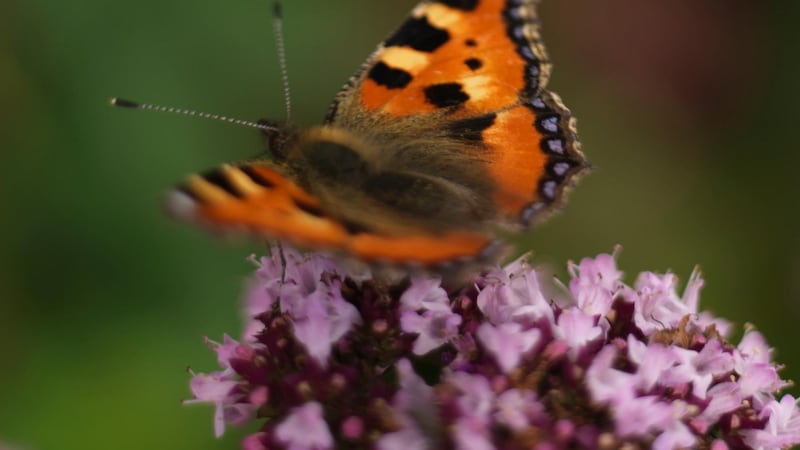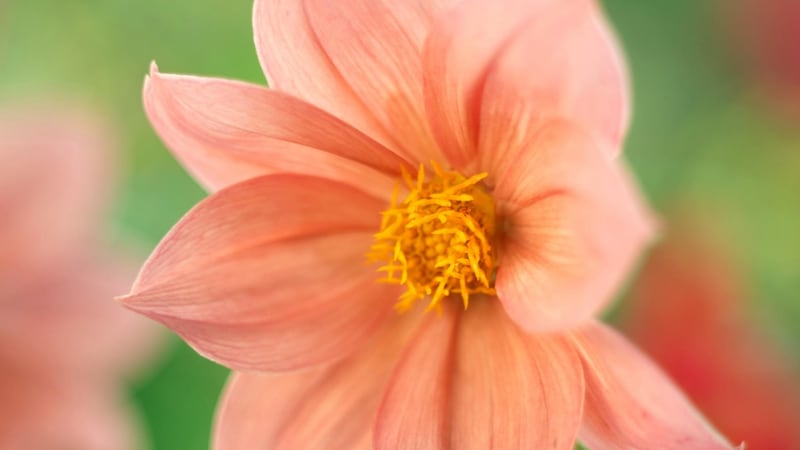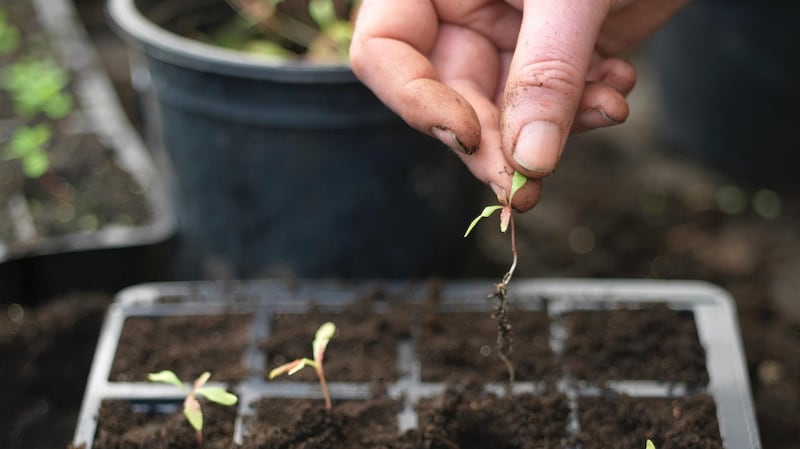With a horde of scientific studies confirming the fact that populations of wild bees, butterflies and other insects are in dramatic decline, many gardeners are wondering what simple steps we can take to make our own little patch of paradise more pollinator-friendly. Here are some handy tips to get you started.
1. Garden a little on the wild side
For example, by allowing a patch of nettles to colonise a small corner, you're providing food for the larvae (caterpillars) of once-common butterflies such as the small Tortoiseshell, Red Admiral, Peacock and Comma, all of which lay their eggs on its leaves. By allowing even a narrow ribbon of lawn to grow uncut, you're helping the Speckled Wood, Wall Brown, Grayling, Gatekeeper, Meadow Brown, Ringlet and Small Heath butterflies, which depend upon various native grasses as a source of food for their larvae.
Long grass also provides the perfect habitat for wild bumblebee nests, while many of the common wild flowers happy to grow in it, such as dandelions, clover, celandines, buttercup and primroses, are also valuable sources of food for pollinating insects. Alternatively, consider mowing your lawn less often, or transforming sections of it into a wildflower-rich meadow by sowing seeds of yellow rattle into it in early autumn. This wonderful little wildflower naturally robs fertility from over-vigorous species of grasses, allowing lots of daintier, pollinator-friendly wild grasses and flowers to thrive in their place.

2. Grow plants for all seasons
While summer is a time of abundance, resident pollinating insects need a steady supply of nectar and pollen from the moment they wake up from their winter hibernation in early spring and take wing in search of food. Autumn-flowering plants are equally important, coming at a time when many are preparing once again for hibernation. So by growing a few spring-flowering garden plants such as hellebores, lungwort (Pulmonaria), honesty (Lunaria) and flowering currant (Ribes), and some autumn-flowering species such as dahlias, sedum, Michaelmas daisies and joe pye weed (Eupatorium), you’ll be giving them a helping hand. Meanwhile, by growing a few pots of snowdrops and crocuses, or allowing wild ivy to colonise a small patch of your garden, you’re providing food in the lean months of late winter and early spring, when rogue warm days make honeybees take flight and tempt bumblebees out of hibernation.
3. Do your very best to avoid using garden chemicals
Especially avoid those containing what are known as neonicotinoids or neonics, a common ingredient in many over-the-counter insecticidal sprays as well as in some pre-treated seed. Similarly, avoid using weedkillers and fungicidal sprays. None of these are good for pollinating insects, or indeed, for humans.

4. Choose single-flowered plants rather than the double-flowered kind
If you’re new to gardening, these terms can sound a little bamboozling, but don’t panic. They’re just ways of distinguishing between flowers with relatively few petals (single-flowered) and those with lots and lots of them (double-flowered). The latter aren’t much use to pollinating insects as their profusion of petals makes it very difficult to access the flowers’ carbohydrate-rich nectar and protein-rich pollen, which they rely on for food. Examples of “open-faced” or single-flowered garden plants include many species-type roses, both the species-type and Bishop-series of Dahlias, and many varieties of cosmos.
5. Grow some trees
It can be easy to forget that the nectar and pollen of the flowers of many common garden trees are abundant sources of food for pollinating insects, especially those that bloom in late winter or spring. Examples include the native hawthorn, hazel, alder, rowan, crab apple, willow, horse chestnut, ornamental cherry and most fruit trees. The flowers of many common garden shrubs such as berberis, forsythia, potentilla, lavender, rosemary, mahonia, viburnum and cotoneaster are also excellent sources of food.

6. Plant a butterfly bush (Buddleja)
The large, nectar-rich flower spikes of this hardy, deciduous shrub appear in late summer and are so attractive to butterflies that it’s not unusual to count dozens of them feeding from a single plant. Depending on the particular variety, those decorative flower spikes can be dark purple (‘Black Knight’), pink (‘Pink Delight’), white (‘White Profusion’), purple-red (‘Royal Red’), or even multicoloured (B x weyeriana ‘Bicolor’), but bear in mind that butterflies are naturally drawn to flowers in shades of orange, purple and dark pink. Although typically a large, slightly sprawling shrub, new ultra-compact forms such as the Podaras series are perfectly suited to container growing.
7. Provide plenty of different habitats
For example, some of our native species of wild bee like to overwinter in the hollow canes of raspberries or the dead flowering stems of perennials. Others prefer sunny, raised banks, or rotting tree stumps, or the bases of hedgerows, or the cavities of stone walls. Likewise, hibernating butterflies need a sheltered spot in winter – perhaps an old outbuilding, a hollow tree stump or even the eaves of a roof. Habitat loss in the wild is one of the greatest causes of pollinator decline, so the greater the variety you can provide in your garden, the better.
(For more useful tips, check out the All-Ireland Pollinator Plan at biodiversityireland.ie)

Dates For Your Diary
The Red Stables, St Anne's Park, Raheny, Dublin (adjacent to the farmer's market), Saturday, March 25th (10am-4pm): the first of the 2017 series of ISNA Plant Fairs, featuring perennials, trees, shrubs, exotics, alpines and garden paraphernalia, see irishspecialistnurseriesassociation.com.
Westonbirt School, Tetbury, Gloucestershire, England: the Second Gardens Illustrated Festival (March 25th-26th) with talks by many of the UK's leading horticulturists, nursery owners and garden designers, including Cleve West, Julian and Isabel Bannerman, Sarah Raven, Arne Maynard and our own Helen Dillon, plus garden tours and plant sales; tickets start from £14.50, see gardensfestival.com for details.
Enable Ireland, Lavanagh House, Ballintemple, Cork, Thursday, March 23rd: (8pm), 'How to Grow Your Own Cut Flowers Seasonally & Sustainably', a talk by Fionnuala Fallon on behalf of the Alpine/Hardy Plants Society (Cork Branch), see alpinegardensociety.ie
This Week in the Garden
Springtime’s bright sunshine has a dramatic effect on daytime temperatures inside glasshouses and polytunnels where they can quickly reach 30 degrees, meaning it’s important to be vigilant as regards ventilation in order to protect seedlings and young plants from damage. So make sure to open doors /windows on sunny mornings and leave them gently ajar until early evening. Conversely, temperatures often drop dramatically with nightfall at this time of year, so close doors and windows in the evening and if necessary, protect seedlings and plants with fleece or an electric glasshouse heater.
If you sowed seeds of annuals and/or vegetables into trays/pots under cover earlier this month, then the seedlings will need to be pricked out into cell-trays or modules, using a good quality seed compost and stored indoors for a few days at room temperature. After pricking out, water the seedlings again and then place them somewhere bright and frost-free but out of direct sunshine until their root systems recover.
First-early varieties of potatoes are traditionally planted at this time of year while second-earlies and maincrop varieties are typically planted a little later, in early April. Remember that potato plants like a rich, moisture-retentive (but not wet), weed-free soil enriched with plenty of manure and positioned in full sun. If blight has been a problem in your garden/allotment in previous years, choose blight-resistant varieties such as Allouette, Bionica, Carolus or Sarpo Mira, all available to order from Cork-based Fruit Hill Farm (fruithillfarm.com).












